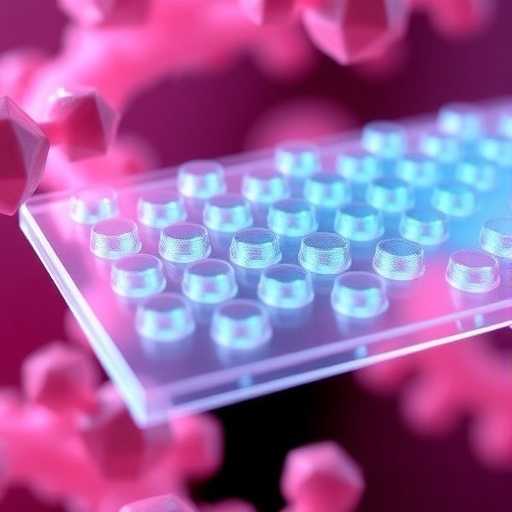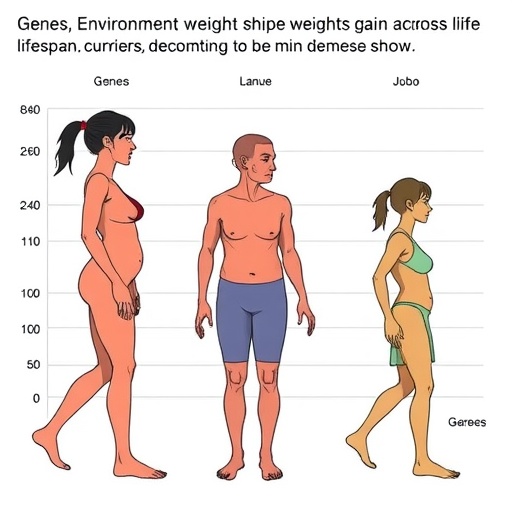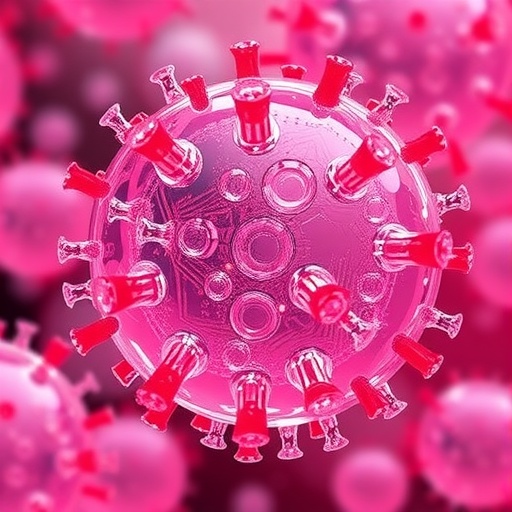
In a groundbreaking advancement that promises to transform the way radiation-induced injuries are managed, researchers have developed nanostructured organic sheets capable of sequestering small extracellular vesicles and reactive species, thus offering robust protection against mucositis triggered by radiation therapy. This innovative approach addresses a long-standing challenge in oncology and radiobiology: mitigating the painful and debilitating side effects caused by radiation-induced damage to the mucosal tissues lining the oral and gastrointestinal tract.
Radiation-induced mucositis is a frequent complication in patients undergoing radiotherapy, especially those treated for head, neck, and pelvic cancers. This condition not only compromises patient quality of life through severe pain and ulceration but also limits the dose of radiation that can be safely administered, thereby hampering therapeutic outcomes. Despite considerable investigation into pharmacological and biologic agents, effective preventive measures have remained elusive, largely due to the complex interplay of molecular and cellular events triggered by radiation exposure.
The study, published recently in Nature Communications, introduces a novel class of functionalized organic nanomaterials engineered to interact specifically with small extracellular vesicles (sEVs) and reactive oxygen species (ROS), both of which play pivotal roles in the pathophysiology of mucositis. These sEVs, which include exosomes and microvesicles, are tiny membrane-bound carriers released by cells undergoing stress or injury, conveying inflammatory signals that propagate tissue damage. Meanwhile, ROS are chemically reactive molecules containing oxygen that cause oxidative stress, DNA damage, and trigger apoptosis in mucosal cells following irradiation.
.adsslot_1FK0StRh3P{width:728px !important;height:90px !important;}
@media(max-width:1199px){ .adsslot_1FK0StRh3P{width:468px !important;height:60px !important;}
}
@media(max-width:767px){ .adsslot_1FK0StRh3P{width:320px !important;height:50px !important;}
}
ADVERTISEMENT
The researchers designed ultrathin organic sheets at the nanoscale, constructed from biocompatible polymeric materials tailored to have high surface-area-to-volume ratios. This structural feature maximizes their capacity to adsorb and neutralize sEVs and ROS before these pathogenic agents reach and harm the mucosal epithelium. By modulating key surface chemistries and optimizing the sheet’s porosity, the team achieved selective affinity toward these harmful targets, effectively transforming the organic nanostructures into molecular ‘sponges’ that can locally reduce inflammatory cascades.
Preclinical tests in animal models exposed to clinically relevant doses of radiation demonstrated that the application of these nanostructured sheets dramatically reduced the onset and severity of mucositis. Histological analysis revealed preserved epithelial integrity, reduced infiltration of inflammatory cells, and diminished ROS-induced oxidative markers in treated tissues compared to controls. Behaviorally, animals exhibited less pain-associated discomfort, correlating with these molecular and cellular findings.
Breaking down the mechanistic interactions, the sheets’ active surfaces bind to membrane proteins and lipid components of sEVs, sequestering them away from mucosal cells and preventing their signaling functions. Concurrently, the materials scavenge free radicals and suppress the cascade of oxidative damage. This synergistic dual-action mechanism interrupts the amplification loops that sustain and exacerbate mucosal injury during radiation therapy.
Beyond the protective role during radiotherapy, the researchers speculate that this technology could have wider applications in other inflammatory disorders where extracellular vesicles and oxidative stress are implicated. Conditions such as inflammatory bowel disease, chronic wounds, and even neuroinflammation might benefit from similar approaches to modulate pathogenic signaling in affected tissues.
From a clinical translation perspective, the nanostructured organic sheets offer practical advantages. Their fabrication relies on scalable and cost-effective polymer chemistry processes, and the materials exhibit favorable biocompatibility profiles with minimal toxicity. Additionally, due to their sheet-like morphology, they can be conveniently applied as topical barriers on mucosal surfaces or incorporated into dressings, making them adaptable to various treatment settings.
The innovation also addresses existing limitations of antioxidant therapies, which often suffer from poor targeting specificity and rapid degradation in vivo. By immobilizing the scavengers within a nanostructured matrix, the therapeutic efficacy is prolonged, and unwanted systemic effects are minimized. This precision in action represents an essential step towards personalized supportive care in oncology.
Furthermore, the ability to trap sEVs opens up new avenues for modulating intercellular communication in the tumor microenvironment. Since sEVs can transport oncogenic molecules and modulate immune responses, controlling their activity locally could impact tumor progression and responses to therapy beyond mucositis management. This raises intriguing possibilities for combining the nanostructured sheets with immunotherapies or chemotherapeutic regimens.
The researchers employed advanced characterization techniques, including electron microscopy, spectroscopy, and bioassays, to verify the physical interactions and biological outcomes. Importantly, the nanomaterials demonstrated stability under physiological conditions and retained their functional capabilities for extended durations, supporting their use in chronic treatment scenarios.
In the broader context of radiation medicine, the advent of these nanostructured organic sheets exemplifies the merging of nanotechnology and molecular biology toward addressing unmet medical challenges. By harnessing the unique physicochemical properties at the nanoscale, the researchers have engineered a novel solution that intervenes dynamically in pathological molecular networks activated by radiation.
As the team progresses towards clinical trials, key focal points will include optimizing delivery methods, confirming long-term safety, and evaluating efficacy across varied radiation protocols and patient populations. Collaboration with clinicians and regulatory agencies will be vital to navigate the path from bench to bedside efficiently.
This pioneering work not only introduces a potent therapeutic tool but also deepens our understanding of the contributions of extracellular vesicles and oxidative stress in radiation-induced tissue injury. By illuminating these intricate mechanisms and offering a strategy to modulate them, it opens a promising frontier in radioprotection and inflammation management.
Ultimately, the development of these nanostructured organic sheets underscores the potential of interdisciplinary research, combining materials science, molecular biology, and clinical medicine to generate impactful solutions that enhance patient outcomes and quality of life in cancer therapy and beyond.
Subject of Research: Radiation-induced mucositis prevention through nanostructured organic materials targeting extracellular vesicles and reactive oxygen species.
Article Title: Nanostructured organic sheets sequestering small extracellular vesicles and reactive species to protect against radiation-induced mucositis.
Article References:
Zhu, Y., Xu, C., Li, Z. et al. Nanostructured organic sheets sequestering small extracellular vesicles and reactive species to protect against radiation-induced mucositis. Nat Commun 16, 6120 (2025). https://doi.org/10.1038/s41467-025-61236-9
Image Credits: AI Generated
Tags: extracellular vesicles in oncologyfunctionalized nanomaterials researchgastrointestinal mucositis solutionshead and neck cancer radiotherapyinnovative nanomaterials for cancer treatmentmucosal tissue protection strategiesnanostructured organic sheetsNature Communications study on radiation injuriesoncology advancements in patient careradiation-induced mucositis preventionradiotherapy side effects mitigationreactive oxygen species management





